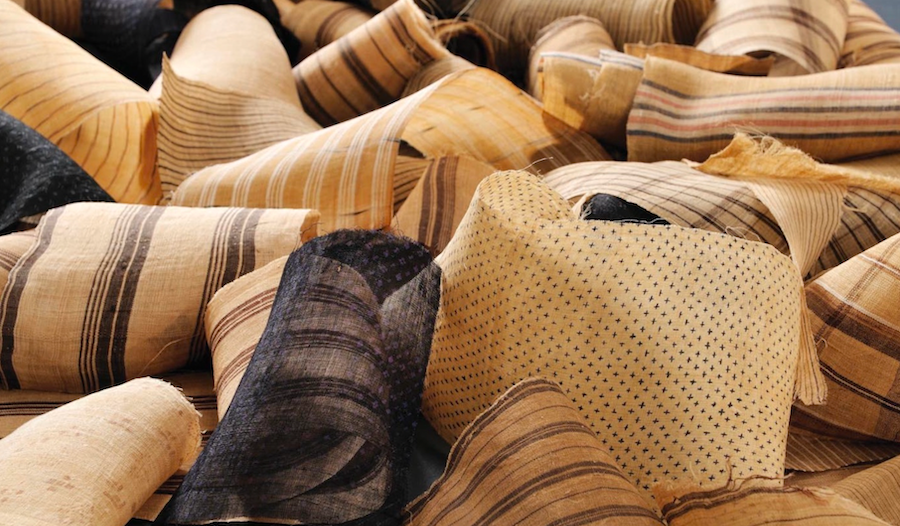
GONE BANANAS
Image: Bashofu lengths. Courtesy of Ryukyu Heritage Textiles
Bashofu is said to have been produced in Okinawa, Japan, since the 13th century. During the Ryuku Dynasty, a specific royal government position was established to management the Basho gardens, in order to obtain high quality bashofu for the royal family, and aristocrats. The fabric is characterised by its smoothness, lightness, and breathability. Known as ‘the wings of a dragonfly’, the firm, fine cloth perfectly suited the hot and humid climate of Okinawa. Later, ordinary people also began to wear bashofu, and it was produced domestically— although this homemade fabric was coarser and rougher to the touch.
 Image: Finished lengths of bashofu. Photo: Okinawa Convention and Visitors Bureau.
Image: Finished lengths of bashofu. Photo: Okinawa Convention and Visitors Bureau.
Original bashofu was mostly plain or striped but, in 1895, the women of Kijoka began to make kasuri (splashed pattern) bashofu, and it then developed as a craft, spawning intensely competitive exhibitions. After an exhibition and sale at Mitsukoshi Department Store, in Tokyo, in 1939, bashofu became more widely known. Production stopped during World War II, but the industry was reconstructed immediately after the war ended in 1945. In 1972, bashofu was designated an intangible cultural asset, and cloth production continues in Kijoka, to this day.
 Image: Bashofu production. Photo: Okinawa Convention and Visitors Bureau.
Image: Bashofu production. Photo: Okinawa Convention and Visitors Bureau.
Basho trees— a particular kind of banana tree, that does not produce the yellow bananas familiar to the West —grow naturally in Okinawa, but in Kijoka the trees have been cultivated over centuries to produce better threads. Pruning to produce threads takes three years, and it takes three months from tree harvesting to a woven bolt of bashofu. Sixty trees are necessary to produce 3.85m2 (4.5 yds2) of bashofu fabric.
 Image: The banana fibre. Courtesy of Maison Fabienne Delvigne.
Image: The banana fibre. Courtesy of Maison Fabienne Delvigne.
Today, Okinawan artisans continue to make bashofu in the manner established hundreds of years ago. First, the skin of the Basho tree is peeled by hand, and separated into four groups. The outmost, hardest layer is used for small products, such as tapestries; the softer, inner layers for kimono; and the inmost layer or dyeing. The peeled skin is then boiled in a wood-ash solution. A bamboo scraper is used to collect the silky fibres from inside the skin, and these are dried and sorted according to softness, with the soft fibres then used for weft threads, and the harder fibres for warp. The dried fibres are spooled into small balls, called chingu, and tied by hand, one by one, to form one long thread. To make the knots inconspicuous is an arduous task, requiring patience and skill. This stage determines the quality of the finished bashofu. Before dyeing, the threads are twisted, misted with water, and the length of the threads is adjusted.

Image: Spun banana thread. Photo courtesy of Spin Flora.
After knotting and dyeing, the threads are woven. Traditionally, this was done in the rainy season, when the humidity would prevent the delicate threads from drying and snapping. Once woven, the fabric is washed and scrubbed with water, and again boiled in wood-ash solution. It is then soaked in a fermented rice water solution to neutralise the alkaline, and to give the fabric strength. Finally, the fabric is stretched to its correct dimensions, and is polished gently with a ceramic cup.
Although this produces a costly fabric, its tradition and beauty ensure it remains in demand.
We are grateful to both Kogei Japan, and to Antique Japanese Folk Textiles, for the technical information included in this article.
